Model (art)

An art model poses for any visual artist as part of the creative process, providing a visual reference for the human figure in a work of art. However, more than being simply the subject of art, models are often thought of as muses, a source of inspiration without whom the art would not exist.[1] The most common types of art works that use models are figure drawing, figure painting, sculpture and photography, but almost any medium may be used.
Beginning with the Renaissance, drawing the human figure from live models was considered the most effective way to develop the skill of draftsmanship. In the modern era it became established that it is best to draw from life, rather than copying two dimensional images such as photographs.[2] In addition, an artist has a connection to drawing another human being that cannot exist with any other subject.[3][4] Models for life drawing classes are usually nude, and what is called the life class became an essential part of the curriculum at art colleges. In the classroom setting, where the purpose is to learn how to draw or paint the human form in all the different shapes, ages and ethnicity, there are no real limitations on who may become an art model.[5]
Role of the model[]
Art models are often paid professionals with skill and experience but are rarely employed full-time, and artists may also rely on friends and family to pose. Paid art models are usually anonymous and unacknowledged subjects of the work.[6] Models are most frequently employed for art classes or by informal groups of artists that gather to share the expense of a model. Models are also employed privately by professional artists. Although commercial motives dominate over aesthetics in illustration, its artwork commonly employs models. For example, Norman Rockwell used his friends and neighbors as models for both his commercial and fine art work.[7]
The role of art models has changed through different eras as the meaning and importance of the human figure in art and society has changed.[8][9] Nude modeling, nude art and nudity in general are at times subject to social disapproval, at least by some elements in society. When the nude in art was popular, the models that made these artworks possible might be of low status and poorly paid. The popular stereotype of the female art model was part of bohemianism in the late 19th and early 20th century Europe. However, the combination of nakedness and the exchange of money led others to associate nude modeling with prostitution, particularly in the United States, where nude modeling might be banned at public universities.[10]:6–7
In the second half of twentieth century, the continued movement of the art world away from representational works reduced the importance of working from models except for the few remaining traditional artists. In art schools, while no longer the inspiration for finished works, drawing from life continues to be recognized as part of the training needed for a complete visual arts education.[10]:8–9
Training and selection[]
Most models learn on the job, but many have experience in the performing arts, athletics, or yoga that provide a basis for posing, such as strength, flexibility, and a well-developed sense of body position.[5] Those that try modeling on a whim and find it to be a rewarding experience then seek to learn more about the job. Some may have previously taken an art class and seen other models, but others rely upon fine art museums and books for suggestions on how to pose.[10]:103–104
In some countries there are organizations which concern themselves with the competence, conduct and reliability of art models. An example is the Register of Artists' Models (RAM) in the United Kingdom.[11] Some basic training is offered to beginners and membership is by audition – to test competence, not to discriminate on grounds of physical characteristics. RAM also acts as an important employment exchange for models and publishes the 'RAM Guidelines', which are widely referred to by models and employers. A similar organization in the United States, the Bay Area Models Guild in California, was founded in 1947. Groups also exist in Australia,[12] Sweden,[13] and several cities in the United States.[14]
These groups may also attempt to establish minimum rates of pay and working conditions, but only rarely have models been sufficiently organized to go on strike.[15][16][17]
Appearance/age/gender[]

Unlike commercial modeling, modeling in an art school classroom is for the purpose of learning how to draw humans of different shapes, ages, and ethnicity.[5]
Children are generally excluded from modeling nude for classes. The minimum age can vary, but is often 15 to 18. Despite being nonsexual in nature, this may be influenced by the age of consent (i.e. at or slightly below). Children are not good candidates for art modeling since they lack the ability to hold still.[10]:9 A small number of photographers such as Sally Mann have done fine art works of their own children.[18] Less well-known photographers have been charged, but not convicted, for suspected child abuse.[19] Jock Sturges photographed entire families of naturists[20] which led to an FBI investigation.[21] Some writers characterize many of these images as sexualizing children regardless of artistic merit.[22]
Gender roles and stereotypes in society are reflected in a different experience for male and female art models, and different responses when those not in the arts learn that someone is a nude model. However, both male and female models tend to keep their modeling career distinct from their other social interactions, if for different reasons. Attitudes toward male nudity, issues of homosexuality when male artists work from male models, and some bias in favor of the female form in art may lead to less opportunity for male models.[10] Works of art that include male nudity are much less marketable.[23] However, historically this has not been the case (See below).
Nudity and body image[]
In recent years, a connection has been made between social issues of body image, sexualization and art modeling, with some promoting life drawing of real people as an alternative to social media representations of idealized bodies.[24]
Posing[]
Poses can range in length from seconds to many hours. There is a drawing exercise where the model slowly but continuously moves, but the shortest is usually one minute. Short dynamic poses are used for gesture drawing exercises or warm-ups, with the model taking strenuous or precarious positions that could not be sustained for a longer pose—just long enough for the artist to quickly capture the essence of it. Drawing sessions proceed through groups of 5, 10, 15, or 20 minute poses generally for a total of three hours. Active, gestural, or challenging standing poses are often scheduled at the beginning of a session when the models' energy level is highest. Specific exercises or lesson plans may require a particular type of pose, but more often the model is expected to do a series of poses with little direction. The more a model knows about the types of exercises used to teach art, the better they become at posing.[23]
- Posing for a typical figure artists' group

Standing (front view)

Reclining

Semi-Reclining/Prone

Sitting

Standing (back view)
Poses fall into three basic categories: standing, seated and reclining. Within each of these, there are varying levels of difficulty, so one kind is not always easier than another. Artists and life drawing instructors will often prefer poses in which the body is being exerted, for a more dynamic and aesthetically interesting subject. Common poses such as standing twists, slouched seated poses and especially the classical contrapposto are difficult to sustain accurately for any amount of time, although it is often surprising what a skilled model can do. The model's level of experience and skill may be taken into account in determining the length of the posing session and the difficulty of the poses.
While posing, a model is expected to remain essentially motionless,[5] and usually remains silent.[10] Exact requirements may vary depending upon the artist or instructor, but an experienced model will not speak, wriggle, scratch, or readjust during the pose. To accommodate the physical limitations, a schedule such as 20 to 25 minutes of posing, with five- or ten-minute breaks is observed. These breaks—during which the model usually wears a robe or puts on clothing—allow the model to stretch, relax and attend to other needs.
In art schools classrooms or studios, the model usually poses on a raised platform called the model stand or dais. In sculpture studios this platform may be built to rotate periodically through the session to allow for a 360° view for every artist.[25] Long poses are generally required for painting (hours or days) and sculpture (perhaps days). To aid in resuming a long pose after a break, chalk marks and/or masking tape are often placed on the model stand.
Types of modeling[]
Academic modeling[]
Models for art classes usually pose nude, though visually non-obstructive personal items such as small jewelry and eyeglasses may be worn. In a job advertisement seeking nude models, this may be referred to as being "undraped" or "disrobed." Art models who pose in the nude for life drawing are also called life models or figure models.

Job description posted by art schools list requirements that are generally limited to being able to hold poses up to 20 to 45 minutes (depending on the institution), and to follow cues from the instructor.[26][27]
Strict rules of conduct are observed to maintain decorum and emphasize the serious intent of figure studies.[28][29] Some schools have lists of guidelines, while others have extensive manuals that describe policies regarding both in-class and outside interaction by models, students, and faculty; with special consideration for issues of sexual harassment. The Columbus College of Art and Design guidelines specifically state that students are discouraged from forming any amorous relationship with models, and must report any existing relationship to avoid possible conflicts. At some institutions students cannot be models, even if they are not art students, as it creates the possibility of conflict for the institution.[30][31][32][33]
Admission to and visibility of the area where a nude model is posing is tightly controlled. Disrobing is done discreetly, and the model wears a robe when not posing.[10] Models may not be accompanied by non-class members.[34] It is generally prohibited for anyone (including the instructor) to touch a model. Very close examinations are only made with the permission of the model. Some institutions allow only the instructor to speak directly with a model. Experienced models avoid any sexually suggestive poses.[10] Art instructors and institutions may consider the incident of a male model gaining an erection while posing cause for termination, or at any rate, grounds for not hiring him again.[35] Guidelines at St. Olaf College discourages students making comments on a model's appearance.[36] Photography is generally forbidden[33]
Any of these policies may vary in different parts of the world. In Europe and South America attitudes are more relaxed, while in China and Korea attitudes are more repressed.[5]
Artist's groups[]
While otherwise similar to art school modeling, groups that meet privately lack instruction. They way be sponsored by arts organizations or galleries; or meet in an artist's private studio or home. Generally the attendees are artists who want to continue the practice of life drawing, and find an informal group easier and more economical, paying a fee for each session or a series.[23][10]
Modeling for individual artists[]
In non-academic settings, models may pose as requested by artists within the limits of the law and their own comfort, including work that requires physical contact with other models, the artist, or the public. French artist Yves Klein applied paint to models' bodies which were then pressed into or dragged across canvas both as performance art and as painting technique.[37] In 2010 at the Museum of Modern Art, a retrospective of the work of Marina Abramović included two nude models standing in a narrow doorway through which visitors passed, replicating a work performed by the artist and a partner in 1977.[38]
However, artists who hire individuals with whom they have no prior relationship tend to observe art school standards in order to make models feel more comfortable, and to avoid possible legal issues. Professional artists often hire the same models on a regular basis. When a comfortable working relationship is established, many artists relax their standards and models do the same. This may be something as simple as not undressing in another room, or not wearing a robe during breaks. In addition, silence is no longer necessary if the artist is comfortable working and conversing with the model. A more collegial relationship may develop where artist and model feel that they are collaborating. However, in a private studio environment, with an artist on a deadline or with commission guidelines, stricter work standards may apply regarding punctuality and holding longer, more demanding poses, but also higher rates of pay. However, private studio work is rare outside of major cities.[10]:9
Chuck Close apologized when several women accused him of making inappropriate comments when they came to his studio to pose, but initially denied any wrongdoing.[39]

Jan de Bray, Cleopatra puts the pearl in the wine, Royal Collection, (1652, first version)
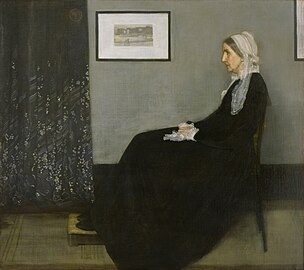
Whistler's Mother, a portrait of Anna by her son, James McNeill Whistler (1871)
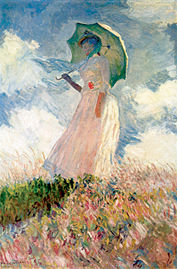
The Woman with a Parasol (Suzanne Hoschedé) by Claude Monet (1886)
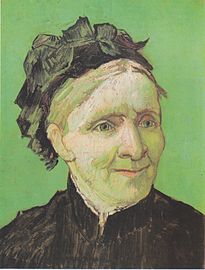
Vincent van Gogh, Portrait of the Artist's Mother, (October 1888)
The Artist and His Family by Lovis Corinth (1909)

Grant Wood's sister Nan Wood Graham, as the Farmer's daughter in American Gothic, (1930)
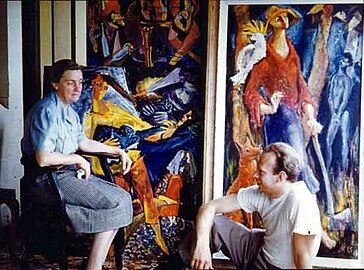
Artist Peter Graham in his studio with his mother as model (1952)
Artists frequently use family members as models, both nude and otherwise, in creating their works. The Dutch Golden Age painter Jan de Bray specialized in the , "portraits" of historical figures using contemporary figures as models, including himself and his family. Among his finest works are two versions of the Banquet of Cleopatra, using his own family, including himself, as models (Royal Collection, 1652, and Currier Museum of Art, New Hampshire, 1669). The second version has great pathos, as most of those depicted had died in the plague of 1663–64.[40]
Lucian Freud painted many of his 14 children, sometimes nude; the most controversial being his daughter Annie Freud in 1963 when she was 14.[41] However, she now looks back upon posing for her father as a positive experience.[42]
The relationship between male photographers and their wives as models is studied in Arthur Ollman's book, The Model Wife. It focuses on the photographers Baron Adolph de Meyer (whose wife was Olga de Meyer), Alfred Stieglitz (whose wife was Georgia O'Keeffe), Edward Weston and model Charis Wilson, Harry Callahan, Emmet Gowin, Lee Friedlander, Masahisa Fukase, Seiichi Furuya, and Nicholas Nixon.[43]

The Prodigal Son in the Tavern portrays two people identified as Rembrandt and his wife Saskia by Rembrandt van Rijn (c. 1635)

The Startled Nymph (modeled by Suzanne Manet) by Édouard Manet (1859–61)

Marie-Hortense Fiquet Cézanne by Paul Cézanne (1877)
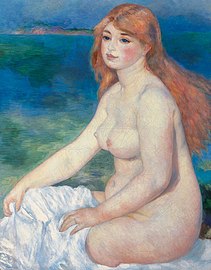
Aline Charigot, La Baigneuse blonde, girlfriend and later wife of Pierre-Auguste Renoir (1882)

Paul Gauguin portrait of his young wife Tehamana, (1893)

Pierre Bonnards wife, Siesta (1900)

Portrait d'Olga dans un fauteuil, (Pablo Picasso's wife Olga in an Armchair), {1917–1918}
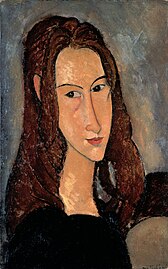
Jeanne Hébuterne by Amedeo Modigliani (1918)

Alfred Stieglitz portrait of Georgia O'Keeffe, (1918)
Clothed modeling[]

Painting classes, and artists doing historical themed works often require clothed or costumed models who take poses that may be sustained until the work is completed. This creates some demand for clothed models in those schools that continue to teach academic painting methods. Some models may promote their services based upon having interesting or varied costumes.[44] Clothing is required in public venues, such as Dr Sketchy's Anti-Art School,[45] but occurs in more traditional settings as well, such as the fund-raising marathons sponsored by the Bay Area Models Guild.[23] Other than costumes, the work requirements and conditions of clothed models for art are identical to that of nude models.
An individual who is having their own portrait painted or sculpted is called a "sitter" rather than a model, since they are not being paid to pose, it is the artist who is being paid to create a likeness.[46] Portraits are now often done from photographs at least in part, although artists prefer to have at least some hours of live sitting at the beginning to better capture the personality, and at the end for final touches. In some cases, the sitter may reject a portrait as an unflattering, and destroy it.[47]
Photography[]
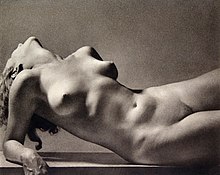
There has been controversy regarding the status of photography as a fine arts medium that is reflected in the unwillingness of some nude models to also pose for photography as they would for drawing or painting.[10]:18–25 The experience of nude modeling for an amateur photographer is different from that of posing for figure drawing/painting.[25] Traditional media create a single image that is not a true likeness of the individual model, but photographs require a release in order to protect the model's right to privacy. The hourly rate of pay for models posing for fine art photography is much higher than for other media, although less than for commercial photography.[10]
Occasionally the distinction of participating in Fine Art may make a young amateur model willing to pose for a photographer, with unexpected consequences; examples being Vanessa Williams and Madonna. A signed print of one of the nude photographs of Madonna taken by Lee Friedlander in 1979 sold at auction in 2012 for $37,000.[48] Although largely a result of her fame, the model does not share in this increased value of the artwork.
Alternative views[]
All of the above is based upon a moderate position regarding the value of figure studies and nudity in art. There are also schools or studios that may be more conservative, or more liberal. Many art programs in Christian institutions consider nudity in any form to be in conflict with their beliefs, and therefore hire only clothed models for art classes.[49] Brigham Young University does not allow nude models, describing their policy as self-censorship within the context of the school's honor code.[50] Other institutions view the absence of figure studies as bringing into question the completeness of the art education offered.[51] Some recognize that an appreciation of the beauty of the human body is compatible with a Christian education.[52] Gordon College not only maintains the need for nude figure studies as part of a complete classical art education, but sees the use of models clad in swimwear or other revealing garments as placing the activity in the context of advertisement and sexual exploitation.[53]
James Elkins voices an alternative to classical "dispassionate" figure study by stating that the nude is never devoid of erotic meaning, and it is a fiction to pretend otherwise.[54] Even the staunch advocate of classical aesthetics Kenneth Clark recognized that "biological urges" were never absent even in the most chaste nude, nor should they be unless all life is drained from the work.[8] However, most models maintain that posing nude need not be any more sexual than any other coed social situation as long as all participants maintain a mature attitude.[10] However, decorum is not always maintained when either a model or the students are not familiar with the often unspoken rules. Models may be apprehensive about posing for incoming freshmen who, having never encountered classroom nudity, respond immaturely.[5][25]
Acceptance of the erotic is apparent in the work and behavior of some artists, for example Picasso was also famous for having a series of model/muse/mistresses through his life: Marie-Thérèse Walter, Fernande Olivier, Dora Maar, and Françoise Gilot. The painter John Currin, whose work is often erotic, combines images from popular culture and references to his wife, Rachel Feinstein.
A feminist view is the male gaze, which asserts that nudes are inherently voyeuristic, with the viewer in the place of the powerful male gazing upon the passive female subject.[55]
History[]
Ancient and Post-classical[]
The Greeks, who had the naked body constantly before them in the exercises of the gymnasium, had far less need of professional models than the moderns; but it is scarcely likely that they could have attained the high level reached by their works without constant study from nature. It was probably in Ancient Greece that models were first used. The story told of Zeuxis by Valerius Maximus, who had five of the most beautiful virgins of the city of Crotone offered him as models for his picture of Helen, proves their occasional use. The remark of Eupompus, quoted by Pliny, who advised Lysippos, "Let nature be your model, not an artist", directing his attention to the crowd instead of to his own work, also suggests a use of models which the many portrait statues of Greek and Roman times show to have been not unknown.[56] The names of some of these models of the era are themselves known, such as the beautiful Phryne who modeled for many paintings and sculptures.[57]
The nude largely disappeared from Western art during the Middle Ages, largely due to the attitude of the early Christians,[58] although in Kenneth Clark's famous distinction "naked" figures were still required for some subjects, especially the Last Judgment. This changed with the Renaissance and the rediscovery of classical antiquity, when painters initially used their male apprentices (garzoni) as models, for figures of both genders, as is often clear from their drawings. Leon Battista Alberti recommends drawing from the nude in his De pictura of 1435; as remained usual until the end of the century, he seems only to mean using male models.[59]:49–50

Raphael, red chalk study for the Villa Farnesina Three Graces (c. 1518)[59]:57
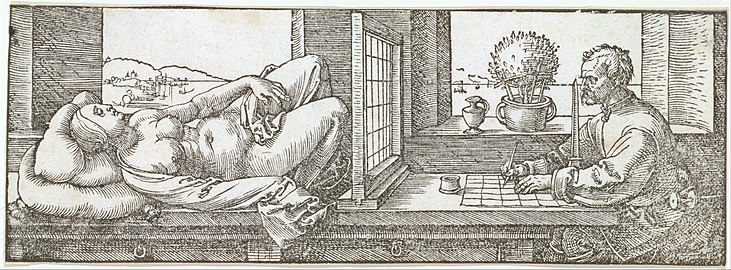
Draughtsman Making a Perspective Drawing of a Reclining Woman, Albrecht Dürer (c. 1600)
Early modern[]
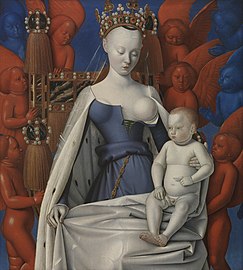
Agnès Sorel was a favourite mistress of Charles VII of France. She was the subject of several works of art.

Olympe Pélissier was a French artists' model and the second wife of the Italian composer Gioachino Rossini.
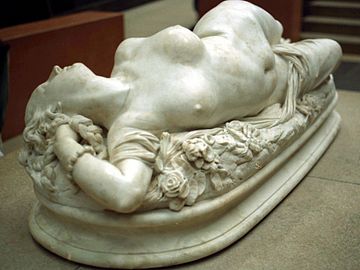
Apollonie Sabatier was a French courtesan, artists' muse and bohémienne in 1850s Paris.
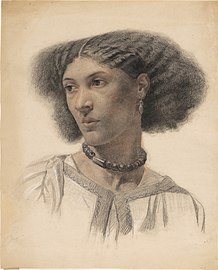
Fanny Eaton, a Jamaican-born British art model known for her work with the Pre-Raphaelite Brotherhood

Rosina Ferrara, an Italian girl from Capri, became the favorite muse of John Singer Sargent.

Suzanne Valadon, Dance at Bougival by Pierre-Auguste Renoir 1883
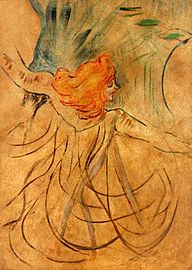
Loie Fuller, Modern Dance pioneer, by Toulouse-Lautrec.

Misia Sert, a pianist of Polish descent; patron and friend of numerous artists, for whom she regularly posed.
Possibly the first images of nude women done from the life are a number of drawings and prints by Albrecht Dürer from the 1490s, which were ahead of Italian practice.[59]:51–55 The production of female nudes suddenly became important in Venetian painting in the decade after 1500, with works such as Giorgione's Dresden Venus of c. 1510. Venetian painters made relatively little use of drawings, and it has been thought that these works did not involve much use of live models, but this view has recently been challenged.[59]:55–56 The first Italian artist to regularly use female models for studies is usually thought to have been Raphael, whose drawings of the female nude clearly do not use teenage boys.[59]:56–60 Michelangelo's earlier Study of a Kneeling Nude Girl for The Entombment (c. 1500) may or may not have used a female model, but if it did this was not his normal practice.[61]
The story of the love between Raphael and his mistress-model Margarita Luti (La Fornarina) is "the archetypal artist-model relationship of Western tradition".[62] There was also a tradition of incorporating donor portraits as minor figures into religious narrative scenes, and several Virgin and Child compositions by court painters are thought to use princesses or other court figures as models for the Virgin Mary; these are sometimes called "disguised portraits".[63]:3–4, 137 [64] The most notorious of these is the portrayal as the Virgo lactans (or just post-lactans) of Agnès Sorel (died 1450), the mistress of Charles VII of France, in a panel by Jean Fouquet.[63]:3–4[65]
Raphael's relationship was probably somewhat untypical, although the Autobiography of Benvenuto Cellini records his use, in both Rome and Paris, of servant girls as model, mistress and maid. However, when he broke with one he had difficulty in finding another model, and was forced to rehire her just to pose.[59]:60–61 Lorenzo Lotto records payments to prostitutes to pose in Venice in 1541, perhaps the earliest record of what long remained an option for artists.[59]:60
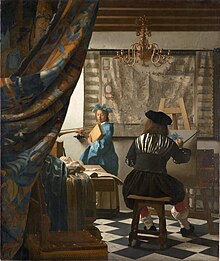
Art modeling as an occupation appeared in the late Renaissance when the establishment of schools for the study of the human figure created a regular demand, and since that time the remuneration offered ensured a continual supply.[56] However, academy models were usually only men until the 19th century, as were the students. The Académie royale de peinture et de sculpture only allowed female models, clothed, from 1759,[59]:61 and in London the students at the female branch of the Royal Academy of Art were only allowed to draw suits of armour to practise their figures until the later 19th century.
The status of nude models has fluctuated with the value and acceptance of nudity in art. Maintaining the classical ideals of Greece and Rome into the Christian Era, nudity was prominent in the decoration of Catholic churches in the Renaissance, only to be covered up with draperies or fig leaves by more prudish successors. The Protestant Reformation went even further, destroying many artworks. From being a possibly glamorous occupation celebrating beauty, being a nude model was at other times equivalent to prostitution, practiced by persons without the means to gain more respectable employment. The costumed models used to create historical paintings may not have been a distinct group, since nude studies were done in preparation for any figure painting.

Late modern and contemporary[]
In 19th-century Paris, a number of models earned a place in art history. Victorine Meurent became a painter herself after posing for several works, including two of the most infamous: Manet's Olympia and Le déjeuner sur l'herbe. Joanna Hiffernan (c. 1843 – after 1903) was an Irish artists' model and muse who was romantically linked with American painter James Abbott McNeill Whistler and French painter Gustave Courbet. She is the model for Whistler's painting Symphony in White, No. 1: The White Girl and is rumored to be the model for Courbet's painting L'Origine du monde. Suzanne Valadon, also a painter, modeled for Pierre-Auguste Renoir (most notably in Dance at Bougival), Henri de Toulouse-Lautrec, Pierre Puvis de Chavannes, and Edgar Degas. She was the mother of the painter Maurice Utrillo.
The second Bal des Quat'z'Arts held in 1893 was a costume ball featuring nude models among the crowd, blurring the distinction between the idealized images in works of art and the real people who posed for them. This was symbolic of other social changes that marked the fin de siècle. Four studio models were convicted of public indecency, which was followed by protests of censorship by students of the École des Beaux-Arts.[66]
When Victorian attitudes took hold in England, studies with a live model became more restrictive than they had been in the prior century, limited to advanced classes of students that had already proved their worthiness by copying old master paintings and drawing from plaster casts.[9]:9 This is in part because many schools were publicly funded, so decisions were under the scrutiny of non-artists.[9]:12 Modeling was not respectable, and even less so for women. During the same period, the French art atelier system allowed any art student to work from life in a less formal atmosphere, and also admitted women as students. In England, the life class became well established as a central element in art education only with the approach of the 20th century.[9]:14–16
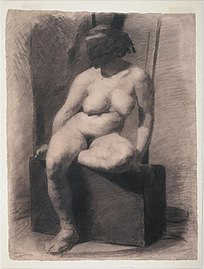
Masked nude, drawing by Thomas Eakins (c. 1863–66)

Two Boys Boxing at the Art Students League of Philadelphia, by Thomas Eakins
In the United States, Victorian modesty sometimes required the female model to pose nude with her face draped (Masked Nude by Eakins, for example).[67]:84 In 1886, Thomas Eakins was famously dismissed from the Pennsylvania Academy of Fine Art for removing the loincloth from a male model in a mixed classroom.[68] 115 European arts academies did not allow women to study the nude at all until the end of the nineteenth century. Even today there remain some schools where the employment of nude models is limited (male models wearing jockstraps) or prohibited, usually for religious reasons.
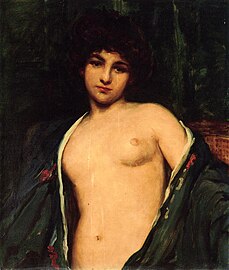
Evelyn Nesbit, a popular American chorus girl and artists' model.

Audrey Munson was the model or inspiration for more than 15 statues in New York City.[69]
In the postmodern era, the nude has returned to gain some acceptance in the art world, but not necessarily the art model. Figure drawing is offered in most art schools, but may not be required for a fine art degree. Peter Steinhart says that in trendy galleries, the nude has become passé,[23] while according to Wendy Steiner there has been a revival in the importance of the figure as a source of beauty in contemporary art.[70] Some established living artists work from models, but more work from photographs, or their imagination. Yet privately held open drawing sessions with a live model remain as popular as ever.[23][71]
In popular culture[]
Films[]

While there have been a number of films that exploited the artist/model stereotype, a few have more accurately portrayed the working relationship.
- Camille Claudel (1988) – Depicts Auguste Rodin and Camille Claudel working in their studio with models.[72]
- La Belle Noiseuse (1991) — An aging artist is coaxed out of retirement by an aspiring young artist's suggestion that his girlfriend pose nude for a new painting.[73]
- Maze (2000) – The film opens with New York painter and sculptor Lyle Maze (Rob Morrow), who has Tourette syndrome, drawing from a model.[74] Later a friend Callie (Laura Linney), also poses for Maze.
- The Artist and the Model (2012) – Set during WWII, an elderly sculptor is prompted to resume working by the arrival of a beautiful Spanish refugee who is willing to pose.[75]
- Renoir (2012) — Tells the story of Catherine Hessling, the last model of Pierre-Auguste Renoir and the first actress in the films of his son, Jean Renoir.[76]
See also[]
- Nude (art)
- The Helga Pictures
- Charis Wilson
References[]
- ^ Annette and Luc Vizin (2003). The 20th Century Muse. New York: Harry N. Abrams, Inc. ISBN 0-8109-9154-3.
- ^ Nicolaides, Kimon (1975). The Natural Way to Draw. Boston: Houghton Mifflin Co. ISBN 978-0-395-20548-8.
- ^ Berry, William A. (1977). Drawing the Human Form: A Guide to Drawing from Life. New York: Van Nortrand Reinhold Co. p. 4. ISBN 978-0-442-20717-5.
- ^ Jacobs, Ted Seth (1986). Drawing with an Open Mind. New York: Watson-Guptill Publications. ISBN 978-0-8230-1464-4.
- ^ Jump up to: a b c d e f Bullock, Linda (2005). Finding Human Form: Artists' Models in Studio and Classroom. Ashville: R.S. Press. ISBN 978-0-9613949-9-8.
- ^ Borzello, Frances (2010). The Artist's Model (2nd ed.). Faber & Faber Limited. ISBN 9780571269822.
- ^ Denny, Diana. "A Day in the Life of Norman Rockwell Model Chuck Marsh". Retrieved November 29, 2012.
- ^ Jump up to: a b Clark, Kenneth (1956). The Nude – A Study in Ideal Form: Chapter 1. The Naked and the Nude. Princeton: Princeton University Press. ISBN 978-0-691-01788-4.
- ^ Jump up to: a b c d Postle, M.; Vaughn, W. (1999). The Artist's Model: from Etty to Spencer. London: Merrell Holberton. ISBN 978-1-85894-084-7.
- ^ Jump up to: a b c d e f g h i j k l m Phillips, Sarah R. (2006). Modeling Life: Art Models Speak about Nudity, Sexuality and the Creative Process. Albany: SUNY Press. ISBN 978-0-7914-6908-8.
- ^ "Register of Artists' Models". Retrieved 2012-03-31.
- ^ "Lifemodelssociety.org". Lifemodelssociety.org. Retrieved 2019-05-16.
- ^ "The Swedish Organization for Life Models". Retrieved 2012-03-31.
- ^ "ArtModelTips.com: List of model guilds and associations". 2012-09-09. Retrieved 2012-11-03.
- ^ "Model's Strike 1941". Trove. Retrieved 2012-10-10.
- ^ "Italian Model's Strike 2008". Fox News. Retrieved 2012-10-10.
- ^ "Paris Model's Strike 2008". Bloomberg News. Retrieved 2012-10-10.
- ^ Mann, Sally; Price, Reynolds (1992). Immediate Family. Aperture. ISBN 978-0893815233.
- ^ Powell, Lynn (2010). Framing Innocence: A Mother's Photographs, a Prosecutor's Zeal, and a Small Town's Response. The New Press. ISBN 978-1595585516.
- ^ "Jock Sturges Biography".
- ^ Harold Maass (July 5, 1990). "Photo Lab Sets Off FBI Probe : Art: Jock Sturges' photographs of nude families are at issue". Los Angeles Times.
- ^ Gordon, Mary (1996). "Sexualizing Children: Thoughts on Sally Mann". Salmagundi. Skidmore College (111): 144–145. JSTOR 40535995.
- ^ Jump up to: a b c d e f Steinhart, Peter (2004). The Undressed Art: Why We Draw. New York: Alfred A. Knopf. ISBN 978-1-4000-4184-8.
- ^ "Body Image and Mental Health: Leading a Life Art Class". Mental Health Foundation. April 26, 2019.
- ^ Jump up to: a b c Rooney, Kathleen (2009). Live Nude Girl: My Life as an Object. Fayetteville: University of Arkansas Press. ISBN 978-1-55728-891-2.
- ^ "Artist Model Ad" (PDF). Kansas City Art Institute. Retrieved September 24, 2019.
- ^ "Job Posting". Kishwaukee College. Retrieved September 24, 2019.
- ^ "Figure Model Guidelines" (PDF). Ringling College of Art and Design. Retrieved September 24, 2019.
- ^ "Policy for the Study of Nude Models in SIUE Figure Drawing Classes". Southern Illinois University Edwardsville. Retrieved September 24, 2019.
- ^ "Job Posting" (PDF). Art Academy of Cincinnati. Retrieved September 24, 2019.
- ^ "Art Model". Classified Staff, Management, and Other Opportunities. Retrieved September 24, 2019.
- ^ "Model for the Department". Oregon State University. Retrieved September 24, 2019.
- ^ Jump up to: a b Amy K. Stewart (March 26, 2008). "UVSC drafts nude-modeling rules". Deseret News.
- ^ "Model Handbook" (PDF). Columbus College of Art and Design. Retrieved September 24, 2019.
- ^ "RAM Guidelines – Contentious Issues". Retrieved 18 October 2012.
- ^ "Modeling Q&A" (PDF). St. Olaf College. Retrieved September 24, 2019.
- ^ "Yves Klein, Anthropometries". Tate Modern. January 17, 2013. Retrieved December 10, 2019.
- ^ Randy Kennedy (March 19, 2010). "Who's Afraid of Marina?". The New York Times.
- ^ Robin Pogrebin (December 20, 2017). "Chuck Close Apologizes After Accusations of Sexual Harassment". THe New York Times. Retrieved October 30, 2019.
- ^ Christopher Lloyd, Enchanting the Eye, Dutch Paintings of the Golden Age, pp. 49-52, Royal Collection Publications, 2004, ISBN 1-902163-90-7.
- ^ Geordie Greig (October 17, 2013). "A Daughter's Tale". Vanity Fair.
- ^ Cunningham, Erin (22 October 2013). "New Book Gives A Rare Glimpse Into The Life of Lucian Freud". The Daily Beast. Archived from the original on 8 July 2018. Retrieved 8 July 2018.
- ^ Ollman, Arthur (1999). The Model Wife. Little, Brown. ISBN 9780821221709.
- ^ "Kimono Model". Atelier Kanawa. Retrieved July 7, 2021.
- ^ Rachel Kramer Bussel. "Model Behavior". The Village Voice. Retrieved 10 October 2012.
- ^ "sitter". Merriam-Webster Online Dictionary. Retrieved November 29, 2012.
- ^ Pierce, Andrew (2008). "Lucian Freud portrait worth millions destroyed by sitter". Retrieved November 29, 2012.
- ^ "Christie's: Nude (Madonna), 1979". Retrieved 20 October 2012.
- ^ Daniel Grant (2011-07-18). "Christian Colleges Struggle with Their Fine Art Programs". Huffington Post. Retrieved 7 October 2012.
- ^ Katelyn Johns (October 19, 2012). "Honor Code and the visual arts". The Daily Universe. Retrieved September 24, 2019.
- ^ White, Jenny (March 1, 2012). "Nudity in art is professional, not sexual". Associated Students of Olivet Nazarene University. Retrieved 2013-02-28.
- ^ "Art Policy on Nude Models" (PDF). Retrieved March 6, 2016.
- ^ "Policy on the Use of Nude Models in Art". Gordon College. Retrieved December 10, 2019.
- ^ Elkins, James (2001). Why Art Cannot Be Taught: A Handbook for Art Students. Urbana: University of Illinois Press. p. 85. ISBN 978-0-252-06950-5.
- ^ Eaton, E.W. (September 2008). "Feminist philosophy of art". Philosophy Compass. 3 (5): 873–893. doi:10.1111/j.1747-9991.2008.00154.x.
- ^ Jump up to: a b One or more of the preceding sentences incorporates text from a publication now in the public domain: Chisholm, Hugh, ed. (1911). "Models, Artists'". Encyclopædia Britannica. 18 (11th ed.). Cambridge University Press. p. 640.
- ^ Cooper, Craig (1995). "Hyperides and the trial of Phryne". Phoenix. 49 (4): 303–318. doi:10.2307/1088883. JSTOR 1088883.
- ^ Sorabella, Jean (January 2008). "The Nude in the Middle Ages and the Renaissance, In Heilbrunn Timeline of Art History". New York: The Metropolitan Museum of Art. Retrieved 25 October 2012.
- ^ Jump up to: a b c d e f g h Bernstein, Joanne G. (1992). "The Female Model and the Renaissance Nude: Dürer, Giorgione, and Raphael". Artibus et Historiae. 13 (26): 49–63. doi:10.2307/1483430. ISSN 0391-9064. JSTOR 1483430. Retrieved 2020-12-08.
- ^ Lathers, Marie (15 October 2013). "Laure". In Jiminez, Jill Berk (ed.). Dictionary of Artists' Models. pp. 315–316. ISBN 9781135959142.
- ^ Dunkerton, 186
- ^ Lathers, Marie (2001). Bodies of Art: French Literary Realism and the Artist's Model. University of Nebraska Press. p. 60. ISBN 978-0-8032-2941-9.
- ^ Jump up to: a b Campbell, Lorne (1990). Renaissance Portraits, European Portrait-Painting in the 14th, 15th and 16th Centuries. Yale University Press. ISBN 0-300-04675-8.
- ^ Ainsworth, Maryan W. (January 2008). "Intentional Alterations of Early Netherlandish Painting". Heilbrunn Timeline of Art History. New York: The Metropolitan Museum of Art.
- ^ *Ainsworth, Maryan Wynn et al., From Van Eyck to Bruegel: Early Netherlandish Paintings in the Metropolitan Museum of Art, p. 192, 2009, Metropolitan Museum of Art, 2009. ISBN 0-8709-9870-6, google books
- ^ Felter-Kerley, Lela (2010). "The Art of Posing Nude: Models, Moralists, and the 1893 Bal Des Quat'z-Arts". French Historical Studies. 33 (1): 69–97. doi:10.1215/00161071-2009-021.
- ^ Boime, Albert (1974). Strictly Academic: Life Drawing in the Nineteenth Century. Binghamton: State University of New York at Binghamton.OCLC 935594325
- ^ Sewell, Darrel (2001). Thomas Eakins. Yale University Press. ISBN 0-87633-143-6.
- ^ Rozas, Diana & Gottehrer Bourne, Anita (1999). American Venus: The Extraordinary Life of Audrey Munson, Model and Muse. Los Angeles: Balcony Press.
- ^ Wendy, Steiner (2001). Venus in Exile: The Rejection of Beauty in Twentieth-century Art. The Free Press. ISBN 978-0-684-85781-7.
- ^ Gail Gregg (2010-12-01). "Nothing Like the Real Thing". ArtNews.
- ^ "Camille Claudel (1988)". IMDB. Retrieved March 6, 2016.
- ^ "Festival de Cannes: La Belle Noiseuse". festival-cannes.com. Retrieved 21 April 2020.
- ^ "Maze (2001)". rottentomatoes.com. Retrieved November 29, 2009.
- ^ "The Artist and the Model (2012)". IMDB. Retrieved March 6, 2016.
- ^ "A Forger's Impressions of Impressionism". The New York Times. 23 March 2013.
Further reading[]
- Lipton, Eunice (1992). Alias Olympia: A Woman's Search for Manet's Notorious Model and Her Own Desires. Cornell University Press. ISBN 978-0-8014-8609-8.
- Steiner, Wendy (2010). The Real Thing: the Model in the Mirror of Art. University of Chicago Press. ISBN 9780226772196.
- Waller, Susan (2006). The Invention of the Model: Artists and Models in Paris, 1830–1870. Burlington: Ashgate. ISBN 978-0-7546-3484-3.
External links[]
| Wikimedia Commons has media related to Model (art). |
- Artists' models
- Visual arts occupations
- Nude art
- Nudity
- Art occupations



































